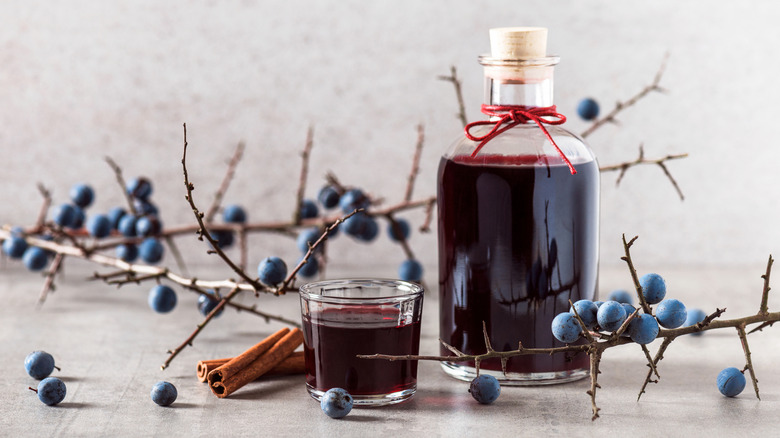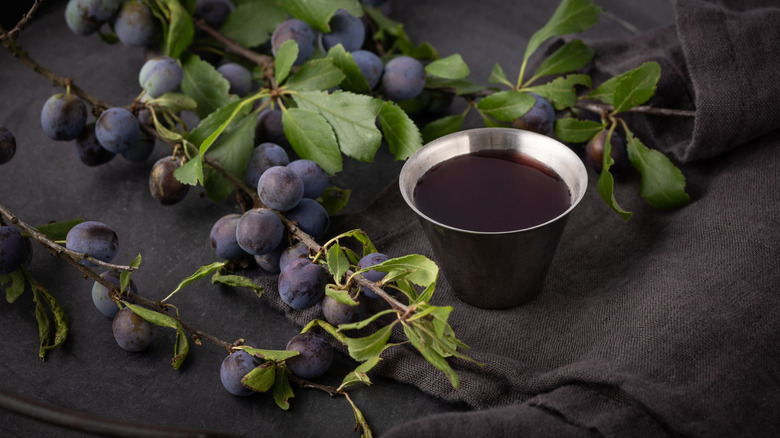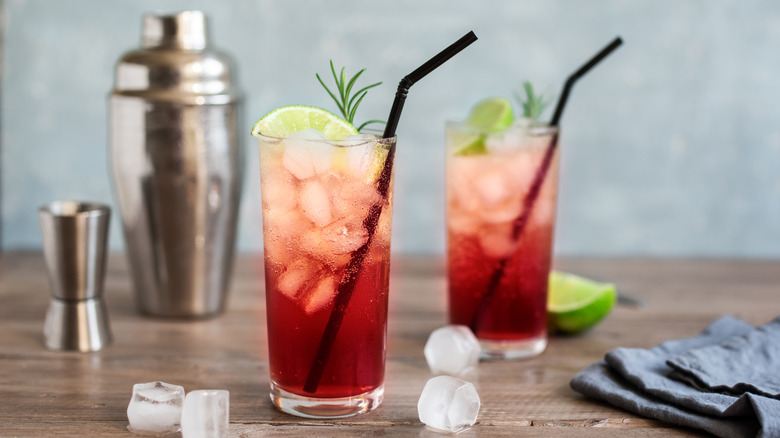Sloe Gin Isn't Actually Gin (But Does It Really Matter?)
Sloe gin has a complicated reputation. In the U.S., it is perhaps most associated with the famous Alabama Slammer, which ruled the college drinking scene in the '70s and '80s. However, sloe gin has a long and storied history that dates back centuries before the Crimson Tide got ahold of it. Its origins lie in 1700s Britain, where hedges of sloe berry bushes lined the borders of many homes. On their own, the berries are unpleasantly bitter, but it turns out that steeping them in gin mellows the flavor to a delightful tartness.
Adding berries to gin has another effect. It means that the drink is no longer technically gin; it's now a liqueur. Not to be confused with liquor, which is a pure, unsweetened spirit, liqueurs are spirits that have been flavored with herbs, spices, nuts, or berries. In this case, gin, which is made by fermenting grains and juniper berries, is a liquor. On the other hand, sloe gin is a liqueur because it has sloe berries added to the base spirit of gin. This has a significant impact on the flavor, color, and alcohol content of the drink. So, while you can use sloe gin in many of the same cocktails you would use regular gin in, there are going to be some differences in the end product.
What sloe gin actually is
Sloe berries are found in Europe, Asia, and Africa, but they are particularly abundant on the islands of Great Britain and Ireland. Sloes are so common there that to this day, many Brits harvest them from the wild and make their own sloe gin at home. It seems that sloe berries are especially subject to misnomers, as not only is sloe gin not technically gin, but sloe berries are not even technically berries. They are actually a type of wild plum, the smallest member of the plum family, in fact. Consequently, they have a stone at the center that makes them all the less appealing as a food source, so you'll rarely see sloes used outside of sloe gin and jams.
Sloe gin is made with three ingredients: sloe berries, sugar, and plain old regular gin. The process is simple, but it takes patience. First, you mix all of the ingredients together and seal them in a jar. The next step is to wait, and wait, and wait some more. Sloe gin needs to be steeped for about three months before it's ready to use. During this time, the sloe berries not only infuse the gin with their tart flavor, but they also color the liquid. The final product has a bright pink hue that makes for some exceptionally eye-catching cocktails.
You can swap gin for sloe gin, but there will be a difference
Sloe gin offers a very different drinking experience from regular gin. While plain gin has a light flavor with notes of pine and citrus, sloe gin has a bit more going on. You still get some flavors from the base gin, but the tartness of the sloe berries and the sweetness of the sugar adds an additional layer of fruitiness. Because it is so unique, sloe gin doesn't typically get mentioned among the best gins for martinis and other classic cocktails, but that shouldn't stop you from experimenting with it. You can use sloe gin in many of the same cocktails you'd use regular gin for, and it is especially popular for giving a fruity twist to the classic gin fizz. Plus, since you can't have a Negroni without a bold gin choice, consider playing the tartness of sloe against the sweet vermouth for a unique experience.
The other thing you need to know about making cocktails with sloe gin is that it has a lower alcohol content than regular gin. Typical gins fall in the range of 40-50% alcohol by volume, which equates to 80-100 U.S. proof. Sloe gin, on the other hand, can range from as little as 15% alcohol by volume up to 30%, which puts it at 30-60 U.S. proof. It doesn't have quite as much kick as plain gin, but it's the perfect thing when you want something lighter to sip.


